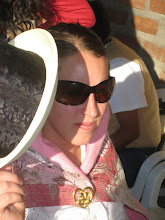Since 80% of the Peruvian population is catholic, Holy Week is one of the largest national holidays of the year. I ended up spending Holy Week in Ica, a coastal department south of Lima, with a few other volunteers. Amazingly, Ica is actually drier than my site but has a similar appearance. Algorrobo trees also dot the landscape; however, in Ica these trees are called huarango. Ica is known for its wineries and as the hub of the small Afro-peruvian population. It was also the epicenter of the 2007 earthquake which struck shortly before I arrived in Perú.
My vacation in Ica included stops in Chincha, Ica, Huacachina, Pisco, and Paracas. Chincha turned out to be a typical Peruvian coastal town, not very noteworthy and not a tourist destination. We attempted to visit an old hacienda there but after a S/.30 taxi ride we discovered it was still closed due to the earthquake.
In Ica we stayed at Huacachina, an odd but pretty oasis in the midst of sand dunes. It’s overrun by tourists but worth a visit nonetheless. Once a ritzy resort for wealthy Limeños, Huacachina is now popular for its dunebuggy rides and sandboarding. While this activity sounds innocent enough it’s really somewhat dangerous. I should have known better as soon as we boarded the dunebuggy with our driver, a Jean Claude Van Damme type who didn’t bother to acknowledge our existence, filled the gas tank while lighting a cigarette, nearly ran into someone before leaving the parking lot, and didn’t wear his seatbelt. Regardless, the dunebuggy portion of our trip turned out to be the safest part. The sandboarding, which is like snowboarding but on sand, was not. Proof in point, I nearly made it down the final hill standing up but terminated my run spiraling around and slamming my head into the ground, hurting my neck in the process. Jean Claude did not ask me how I was but rather commented that everyone breaks their clavicle that way. I’m still not sure how I would have broken my clavicle but who am I to say. Later that night I saw him drinking at our hostal. He mumbled some gibberish to me which must have meant, “How’s your neck?” and then hit me on the back of my neck. Literally, he hit me.
While in Ica we also visited a couple of wineries and an excellent chocolate factory (Helena’s.) Rather than opting for the hostal’s package tour we did this on our own which cost less than half as much. We spent the savings on chocolate.
The final stop of our trip was Pisco where we stayed in the room of a fellow volunteer, Aaron, who has the good fortune to step out his front door to a beautiful ocean view. Pisco was hit hard by the 2007 earthquake and, approaching two years later, the effects can still be seen. On the outskirts of the town the shantytowns are much larger than I expected. Adobe houses which were left standing are mixed with a smattering of temporary housing.
From Pisco we visited the Islas Ballestas on a boat tour. The islands are part of Paracas National Park, a coastal desert ecosystem preserved for the large amount of coastal wildlife it protects. Called the “Poor Man’s Galapagos” in Lonely Planet, the islands don’t really compare to the Galapagos but are home to an incredible number of birds including penguins. A secluded nesting beach overflowing with hundreds, maybe thousands, of sea lions and their cubs, reminded me of a scene typical of National Geographic.
-------
I wear a seatbelt so infrequently in Perú that I don’t think twice about riding in a vehicle without one. More than once I have had a seatbelt available to me which I didn’t even wear because encountering one here is such a rarity that I no longer bother to check. Moto-taxis clearly don’t have seatbelts but I’ve always just assumed that they were a safe form of transport. On the moto-taxi back to my site after vacation I was feeling particularly safe, especially in comparison to my recent dunebuggy ride. Then, rounding a curve near my community, the moto-taxi I was on collided with an oncoming moto-taxi propelling the driver of my moto-taxi through the air. The moto-taxi almost landed on top of me but, luckily, we were going slowly and I only bruised my arm. The driver of the other moto-taxi started yelling at the poor kid who went flying through the air before he was even standing. Seriously though, the accident was absurd. Both of them were driving on the wrong side of the road. My moto-taxi driver decided to move to the correct side while the other driver decided to do nothing. As we were approaching the other moto-taxi I recall thinking that surely one of them was going to stop or move out of the way. Instead they just ran right into each other. Just kept going straight ahead as if there were no other option. To top it off, they decided to settle the matter somewhere else and drove off without a word, leaving me and the other passenger, an old farmer, standing on the side of the road to wait for another moto-taxi.
-------
Happy Feet was on television last Sunday. My little brother could hardly contain his excitment. Halfway through the movie he turned to me and declared matter-of-factly that all those penguins weren’t actually real but rather they were humans dressed up in penguin costumes. He sounded so proud that he had figured out the trick that I felt bad informing him that it was actually a cartoon.
During the movie my host-mom also told me that for two years while she lived in Lima, she had a pet penguin which they had discovered one day in the Río Rimac, the major river which runs through the city. His name was Juan. Just to clarify, penguins are NOT natural inhabitants of Lima.
